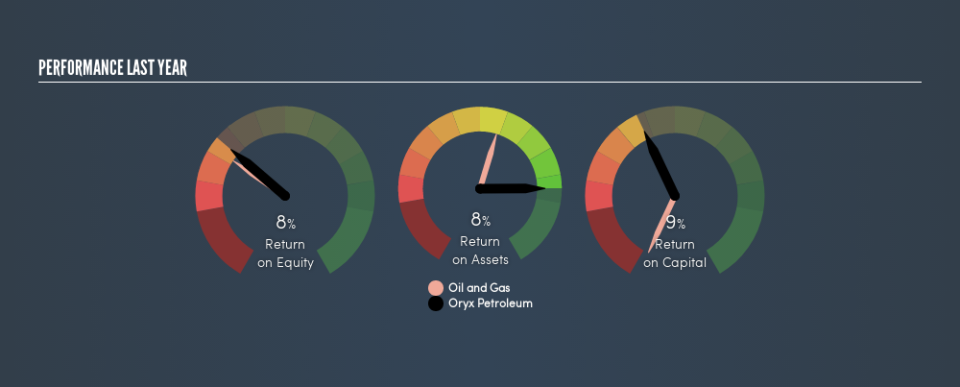Why We Like Oryx Petroleum Corporation Limited’s (TSE:OXC) 9.0% Return On Capital Employed

Want to participate in a short research study? Help shape the future of investing tools and you could win a $250 gift card!
Today we are going to look at Oryx Petroleum Corporation Limited (TSE:OXC) to see whether it might be an attractive investment prospect. To be precise, we'll consider its Return On Capital Employed (ROCE), as that will inform our view of the quality of the business.
First up, we'll look at what ROCE is and how we calculate it. Next, we'll compare it to others in its industry. Finally, we'll look at how its current liabilities affect its ROCE.
Return On Capital Employed (ROCE): What is it?
ROCE is a measure of a company's yearly pre-tax profit (its return), relative to the capital employed in the business. Generally speaking a higher ROCE is better. Ultimately, it is a useful but imperfect metric. Renowned investment researcher Michael Mauboussin has suggested that a high ROCE can indicate that 'one dollar invested in the company generates value of more than one dollar'.
So, How Do We Calculate ROCE?
Analysts use this formula to calculate return on capital employed:
Return on Capital Employed = Earnings Before Interest and Tax (EBIT) ÷ (Total Assets - Current Liabilities)
Or for Oryx Petroleum:
0.09 = US$67m ÷ (US$810m - US$61m) (Based on the trailing twelve months to March 2019.)
So, Oryx Petroleum has an ROCE of 9.0%.
View our latest analysis for Oryx Petroleum
Does Oryx Petroleum Have A Good ROCE?
When making comparisons between similar businesses, investors may find ROCE useful. Oryx Petroleum's ROCE appears to be substantially greater than the 5.5% average in the Oil and Gas industry. I think that's good to see, since it implies the company is better than other companies at making the most of its capital. Aside from the industry comparison, Oryx Petroleum's ROCE is mediocre in absolute terms, considering the risk of investing in stocks versus the safety of a bank account. Readers may find more attractive investment prospects elsewhere.
Oryx Petroleum has an ROCE of 9.0%, but it didn't have an ROCE 3 years ago, since it was unprofitable. That suggests the business has returned to profitability.
When considering ROCE, bear in mind that it reflects the past and does not necessarily predict the future. ROCE can be deceptive for cyclical businesses, as returns can look incredible in boom times, and terribly low in downturns. ROCE is only a point-in-time measure. We note Oryx Petroleum could be considered a cyclical business. If Oryx Petroleum is cyclical, it could make sense to check out this free graph of past earnings, revenue and cash flow.
What Are Current Liabilities, And How Do They Affect Oryx Petroleum's ROCE?
Current liabilities are short term bills and invoices that need to be paid in 12 months or less. The ROCE equation subtracts current liabilities from capital employed, so a company with a lot of current liabilities appears to have less capital employed, and a higher ROCE than otherwise. To counter this, investors can check if a company has high current liabilities relative to total assets.
Oryx Petroleum has total assets of US$810m and current liabilities of US$61m. Therefore its current liabilities are equivalent to approximately 7.6% of its total assets. Oryx Petroleum has a low level of current liabilities, which have a minimal impact on its uninspiring ROCE.
The Bottom Line On Oryx Petroleum's ROCE
If performance improves, then Oryx Petroleum may be an OK investment, especially at the right valuation. But note: make sure you look for a great company, not just the first idea you come across. So take a peek at this free list of interesting companies with strong recent earnings growth (and a P/E ratio below 20).
I will like Oryx Petroleum better if I see some big insider buys. While we wait, check out this free list of growing companies with considerable, recent, insider buying.
We aim to bring you long-term focused research analysis driven by fundamental data. Note that our analysis may not factor in the latest price-sensitive company announcements or qualitative material.
If you spot an error that warrants correction, please contact the editor at editorial-team@simplywallst.com. This article by Simply Wall St is general in nature. It does not constitute a recommendation to buy or sell any stock, and does not take account of your objectives, or your financial situation. Simply Wall St has no position in the stocks mentioned. Thank you for reading.

 Yahoo Finance
Yahoo Finance 
